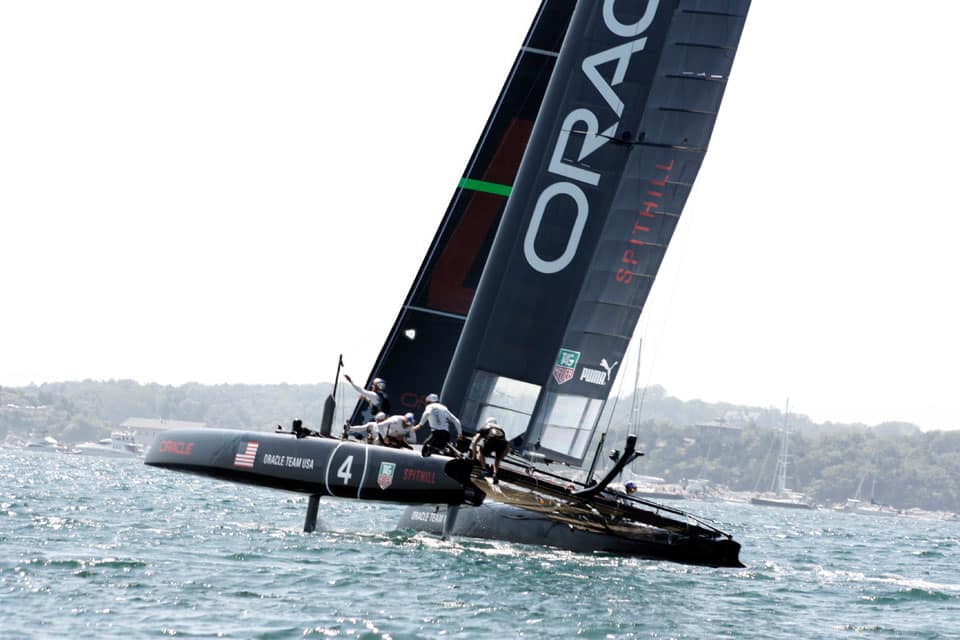
ac10.jpg
In July, America’s Cup racing returned to Newport, Rhode Island for the first time since 1983. That year, Australia II, the wing-keeled challenger designed by Ben Lexcen, defeated Liberty, the New York Yacht Club’s defender skippered by Dennis Conner. This time around, the competition was conducted in 45-foot wing-sail catamarans, and the racing itself was not in fact for the America’s Cup, but as part of a worldwide tour of regattas called the America’s Cup World Series (see “Newport’s Cup Date” from the July issue of CW).
Confusing? Well, yes. To put things in context, here’s a quick primer to the next actual America’s Cup match—the 34th since the original race in 1851—to be held aboard 72-foot catamarans in San Francisco Bay in September, 2013.
What is the America’s Cup World Series?
The AC World Series was conceived for two reasons: to broaden interest in the America’s Cup and to give prospective challengers the opportunity to become familiar with wing-sail mulithulls aboard identical 45-foot catamarans before designing and building the AC 72 cats that will be raced in San Francisco in 2013. The AC World Series’ first season concluded in Newport in July 2012. There will be four events—two in San Francisco, one in Venice, and one in Naples—leading up to the challenger’s trials that begin on July 4, 2013. For more on the schedules, history, and entrants, visit the event’s website (www.americascup.com) and for more in-depth coverage visit .
Who will defend the America’s Cup?
Oracle software founder Larry Ellison won the Cup and earned the right to defend it in February 2010. New Zealander Russell Coutts and skipper James Spithill, an Australian, lead Ellison’s Oracle Team USA syndicate.
Who are the challengers?
While eight teams participated in the World Series—including squads representing Korea, France, and China—there are three syndicates that are locks to race in San Francisco (the others are still searching for funds). The Challenger of Record is Sweden’s Artemis Racing, skippered by the lone American helmsman in the group, Terry Hutchinson. Emirates Team New Zealand, and Italy’s Luna Rossa, are the other confirmed challengers thus far, both of which are America’s Cup veterans.
What is the Louis Vuitton Cup?
Since 1983, the series to decide who will challenge for the Cup has been sponsored by the luxury luggage and fashion brand Louis Vuitton, who awards their eponymous Cup to the winning syndicate. In Newport, LV Chairman and CEO Yves Carcelle—an accomplished sailor in his own right who races a classic yawl called Runa IV—spoke about his company’s involvement: “When we heard that monohulls would be replaced by catamarans for 2013, it was a bit of a shock. Now with the AC 45s, we’ve seen that multihulls are exciting, breathtaking, and dangerous. The question now is, what will the racing be like in the 72-footers? We are very proud that the first time they will be sailed in competition is at the beginning of the Louis Vuitton Cup.”
So what’s the big deal with the AC 72 foot cats?
As Carcelle says, especially with the stunning backdrop of the San Francisco skyline and the beauty of the Bay, the big cats should be a breathtaking spectacle. Sailed by 11-man crews, with wings that tower some 130-feet over the water, the boats will be capable of speeds over 40-knots. Unlike the one-design, identical AC 45s, the AC 72s will be designed independently and each should be radically different. Oracle, for example, has been testing prototypes with hydrofoils that lift both hulls out of the sea. As Conner once said, “The America’s Cup is really a design contest. The racing is how they keep score.” The same should be true in San Francisco in 2013.
What other innovations are in store?
The mantra of Ellison’s group is “Bring the racing to the people.” To do so, the competition will be held close to shore, as it was with the World Series events. That said, from a spectator’s point of view, the television coverage might be even better. Oracle has hired accomplished sailor and navigator Stan Honey—an Emmy winning computer genius who invented the yellow first-down marker for football telecasts, among other innovations—to spearhead the TV effort, and the graphics technology he’s created is truly revolutionary.
So why should cruising sailors care about any of this?
If you love sailing, these giant cats should provide plenty of thrills, and perhaps spills. And if it’s really great, it might bring more kids and enthusiasts into our sport, which can’t be a bad thing. Either way, here at CW, we can’t wait to watch the powerful cats prowling on San Francisco Bay.







